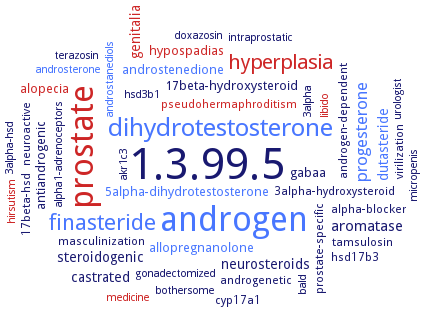1.3.99.5: 3-oxo-5alpha-steroid 4-dehydrogenase (acceptor)
This is an abbreviated version!
For detailed information about 3-oxo-5alpha-steroid 4-dehydrogenase (acceptor), go to the full flat file.

Word Map on EC 1.3.99.5 
-
1.3.99.5
-
androgen
-
prostate
-
dihydrotestosterone
-
finasteride
-
hyperplasia
-
progesterone
-
aromatase
-
steroidogenic
-
castrated
-
dutasteride
-
neurosteroids
-
genitalia
-
alopecia
-
5alpha-dihydrotestosterone
-
androstenedione
-
antiandrogenic
-
17beta-hydroxysteroid
-
hypospadias
-
gabaa
-
allopregnanolone
-
17beta-hsd
-
masculinization
-
androgenetic
-
tamsulosin
-
virilization
-
androgen-dependent
-
cyp17a1
-
3alpha-hydroxysteroid
-
hsd17b3
-
neuroactive
-
pseudohermaphroditism
-
alpha-blocker
-
prostate-specific
-
libido
-
bald
-
alpha1-adrenoceptors
-
bothersome
-
intraprostatic
-
micropenis
-
terazosin
-
doxazosin
-
androstanediols
-
gonadectomized
-
urologist
-
3alpha
-
hirsutism
-
3alpha-hsd
-
androsterone
-
medicine
-
hsd3b1
-
akr1c3
- 1.3.99.5
- androgen
- prostate
- dihydrotestosterone
- finasteride
- hyperplasia
- progesterone
- aromatase
-
steroidogenic
-
castrated
- dutasteride
-
neurosteroids
- genitalia
- alopecia
- 5alpha-dihydrotestosterone
- androstenedione
-
antiandrogenic
-
17beta-hydroxysteroid
- hypospadias
-
gabaa
- allopregnanolone
- 17beta-hsd
-
masculinization
-
androgenetic
-
tamsulosin
-
virilization
-
androgen-dependent
- cyp17a1
-
3alpha-hydroxysteroid
- hsd17b3
-
neuroactive
- pseudohermaphroditism
-
alpha-blocker
-
prostate-specific
- libido
-
bald
-
alpha1-adrenoceptors
-
bothersome
-
intraprostatic
-
micropenis
-
terazosin
-
doxazosin
- androstanediols
-
gonadectomized
-
urologist
-
3alpha
- hirsutism
- 3alpha-hsd
- androsterone
- medicine
- hsd3b1
- akr1c3
Reaction
Synonyms
3-keto-DELTA4-steroid-5 alpha-reductase, 3-ketosteroid-DELTA4(5alpha)-dehydrogenase, 3-oxo-5alpha-steroid DELTA4-dehydrogenase, 3-oxo-steroid-4-ene dehydrogenase, 3-oxosteroid DELTA4-dehydrogenase, 4-ene-3-ketosteroid-5alpha-oxidoreductase, 5 alpha-SR2, 5-alpha reductase II, 5alpha reductase, 5alpha-R, 5alpha-R1, 5alpha-reductase, 5alpha-reductase II, 5alpha-reductase type 1, 5alpha-reductase type 2, 5alpha-reductase type II, 5alpha-reductase type1, 5alpha-reductase type2, 5alphaR1, 5alphaR2, 5AR2, dehydrogenase, 3-oxo-5alphasteroid DELTA4-, DELTA4(5alpha)DH, DELTA4-3-keto steroid 5alpha-reductase, DELTA4-3-ketosteroid 5alpha-oxidoreductase, DELTA4-3-oxo steroid reductase, DELTA4-3-oxosteroid-5alpha-reductase, DELTA4-5alpha-dehydrogenase, NADPH-dependent 5alpha-reductase enzyme, r5alphaR1, S5alphaRI, S5alphaRII, S5AR, SRD5A1, SRD5A2, SRD5alpha, steroid 5-alpha reductase type 2, steroid 5-alpha-reductase type 2, steroid 5alpha-reductase, steroid 5alpha-reductase type 1, steroid 5alpha-reductase type 2, steroid DELTA4-5alpha-reductase, steroid-5alpha-reductase, testosterone 5alpha-reductase, type 1 5alpha-reductase, type 2 5alpha-reductase, type I 5alpha-reductase, type II 5alpha-reductase


 results (
results ( results (
results ( top
top





